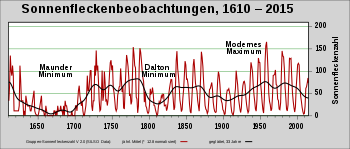Dalton minimum


The Dalton Minimum (after the English researcher John Dalton ) was a period of reduced solar activity between approximately 1790 and 1830.
The period was accompanied by a particularly cool earth climate. During the so-called Little Ice Age , there were repeated negative deviations in the global mean temperature. This was reinforced in particular by the Tambora eruption and the following year without the summer of 1816.
Previous minima were the Maunder Minimum (1645-1715) and the spörer minimum (1420-1550); after the dalton minimum, the modern maximum followed (1914–2000). There are indications that the modern maximum, after having passed its peak around 1960, could now transition into a new minimum.
At the 24th General Assembly of the International Astronomical Union in 2015, a revised series of data from 1750 was presented after the observation conditions were checked again, which now show less low and higher sunspot numbers around 1885 and 1945. This means that the dalton minimum is also less extreme in the time series.
Web links
- Graphs demonstrating improved agreement between Old and New Sunspot Numbers and The Newly Calibrated sunspot Group Number over the last 400 years (iau.org, August 2015, to press release iau1508)
Individual evidence
- ↑ a b c Corrected Sunspot History Suggests Climate Change since the Industrial Revolution not due to Natural Solar Trends. International Astronomical Union press release, iau1508, August 7, 2015 (iau.org, accessed August 20, 2015).
- ↑ Dalton minimum. In: Encyclopædia Britannica Online. Retrieved November 29, 2014.
- ↑ G. Usoskin et al. a .: Evidence for distinct modes of solar activity . In: Astronomy & Astrophysics . 2014, doi : 10.1051 / 0004-6361 / 201423391 .
- ↑ Sarah Ineson et al. a .: Regional climate impacts of a possible future grand solar minimum . In: Nature Communications . June 23, 2015, doi : 10.1038 / ncomms8535 .